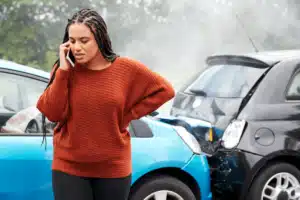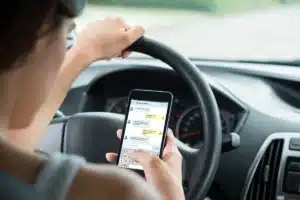California Rear-End Collision Laws
California’s Vehicle Code affects who is responsible for rear-end collisions, mandates who can sue, and sets the statute of limitations for filing lawsuits. If you were recently involved in a rear-end accident in California, you must understand California Vehicle Code to determine who is at fault.
- The CVC 21703 mandates that drivers maintain a prudent and reasonable distance from the vehicle in front to prevent rear-end collisions.
- Generally, in rear-end collisions, the rear driver is considered at fault.
- Fault can shift to the front driver if they violate traffic laws, such as sudden braking without cause or reversing unexpectedly.
- Other relevant codes include Section 22109 (suddenly stopping without signaling), Section 22350 (abiding by the fundamental speed law), and Section 22100.5 (rules regarding U-turns).
What Is CVC 21703?
California Vehicle Code 21703 requires that you leave a prudent and reasonable distance between you and the vehicle in front of you. This distance depends on the condition of the roadway, traffic, and the vehicle.
The law provides no one-size-fits-all definition of what a reasonable distance is. Every accident is different. Because of the lack of a clear definition, you may need a California rear-end law firm like Cutter Law to represent you if witness statements differ after an accident.
Other Important California Vehicle Codes for Rear-End Collisions
If you have been in an accident, it’s important to understand other provisions of the California Vehicle Code that may apply to rear-end collisions.
Vehicle Code Section 22109 – Suddenly Stopping Without Signaling
You cannot stop or slow down suddenly on a California highway without signaling appropriately. This gives the driver behind you the chance to slow down with you. This means your vehicle needs functioning brake signals.
Vehicle Code Section 22350 – the Fundamental Speed Law
You must choose a prudent, reasonable speed and not over the posted speed limit. Determine the appropriate speed by considering visibility, weather, and road size.
Vehicle Code Section 22100.5 – U-turns
U-turns are generally illegal on roads with official traffic signals. There are special exceptions, but the turn must be made from the far left lane.
Vehicle Code 21750 (a) – Overtaking and Passing on Roadway
You can only pass someone going the same direction on the left side, and only when it poses no risks to the car you are passing.
Fault in a Rear-End Collision in California
The California Vehicle Code has 13 chapters, is 100 pages long, and involves lots of legal jargon. We do not expect you to understand all the ins and outs and thus want to help break it down to the basics if you are in an accident.
The laws governing rear-end collisions in California provide that the rear driver is generally at fault in most cases. However, if the front driver violates part of the code, they may be at fault. These violations include but are not limited to:
- Slamming on the breaks suddenly for no valid reason
- Broken vehicle brake lights
- Front driver going into reverse
- Cars not moved to the side of the road when they have mechanical problems
Every situation is different, and some cases are hard to decide. Fines for at-fault citations, vehicle repair, and medical bills after an accident can add up. If you sustained injuries because a driver behind you violated the code, we can help you.
If three or more cars are involved in the accident, the driver who initiated the contact is at fault unless the driver in front was brake-checking. Brake-checking is when a driver presses on the brakes unexpectedly to affect the car behind them. If a driver hits the middle car, causing it to rear-end the front car, the initial driver is most often responsible.
The Legality of Tailgating in California
Tailgating, or following too closely, falls under Section 22400. It is illegal to impede or block the normal and reasonable traffic flow. If your vehicle slows down or comes to a stop due to compliance with the law, mechanical issues, or the terrain of the road, it is considered legal.
What to Do After a Rear-End Collision
Car accidents are scary, no matter how big or small. After an accident, you may panic or feel foggy. We encourage you to do the following after an accident to obtain accurate evidence.
Immediately seek medical attention for anyone injured
This is a priority, and you can move cars and disrupt the scene to help treat the injured.
Call 911 or the Police
Many people exchange insurance information in small accidents like rear-end collisions, but we encourage you to remain at the scene until authorities arrive and take witness statements. If you must sue for damages, the police report will be extremely important.
An accident qualifies as a hit-and-run if the at-fault driver flees the scene, and you must notify the police within a certain period to file a report.
Gather Information
Collect the following information from all involved and any witnesses:
- Addresses
- Names
- Phone numbers
- Driver license number
- License plate number
- Vehicle identification number
Take Photos
Be sure to get clear photos of the damage and the scene. Include anything that affected the accident, such as visual obstacles or traffic controls.
Next Steps
After the dust has settled from the accident, you can call the at-fault driver’s insurance company and file a claim. Be aware that the insurance company may not give you the compensation you deserve; that is where a California rear-end collision law firm can help.
If the damage exceeds $750 or someone gets hurt in the accident, you must report it to the Department of Motor Vehicles within ten days. Failing to do this can influence the status of your license.
Contact the Rear End Accidents Lawyers at Cutter Law P.C.
Understanding the California Vehicle Code (CVC) is important when you are in an accident. At Cutter Law, we have extensive experience in rear-end collision law, and we understand the California Vehicle Code. We serve those who have been in a car accident and have not received the compensation they deserve. Our California rear-end law attorneys can advise you on your case and fight for the compensation you deserve for injuries, repairs, and other expenses.
We provide a free case review for anyone injured in an accident. Contact an attorney at our firm today to determine if you have a case.
I hired John Roussas at Cutter Law to resolve a case involving a motor vehicle accident, in which my wife were rear-ended. The counter party’s insurance company offered a settlement under $1000 even though medical bills totaled several thousand dollars.
John and his team did an exceptional job resolving the case, that ultimately resulted in a settlement significantly higher than the initial offer; they acted professionally and efficiently, were accessible, and easy to communicate with. I highly recommend John and his team and would hire them again if the need arose.
FAQs
What Are Common Car Accident Injuries?
Head injuries are common in car accidents and may manifest immediately after the accident or not for several weeks. If you fear you have a head injury after an accident, always seek medical help.
Other common injuries caused by car accidents include but are not limited to:
- Neck injuries
- Back injuries
- Spinal cord injuries
- Fractures
- Burn injuries
What Are the Common Causes of Car Accidents?
Many accidents happen because of drunk driving and impaired driving. Another major cause is distracted driving, including texting, eating, or talking on the phone.
Other accidents happen because of speeding, aggressive driving, automotive defects, road hazards, and poor weather.
What Is the Statute of Limitations for Car Accidents in California?
California has a two-year statute of limitations for personal injuries suffered in car accidents. You must file a lawsuit within two years of the day the incident happened.
The statute of limitations for property damage is three years.
How Do I Report a Car Accident in California?
To report an accident in California, call 911, the local police, or the California Highway Patrol.
Do I Need a Lawyer to Handle My Case?
We encourage you to seek the help of a lawyer after any accident, including a rear-end collision.
We can help you fight for compensation for medical bills, vehicle repairs, and any other damages. If you cannot work after an accident, you may deserve damages for lost wages. You may also seek compensation for damages that are not easily quantified but are just as real, like emotional distress and pain and suffering.
We have the answers to all your questions about rear-end collision law in California. Contact Cutter Law for a free consultation.

Taking the proper steps after a car accident will give you the best shot at recovering the maximum compensation in an insurance claim.

In California, you can file a claim directly with the at-fault driver’s insurance company. You must provide evidence of the accident and documentation of your damages.

California allows you to recover some compensation as long as your share of the fault for the accident is less than 100 percent.
